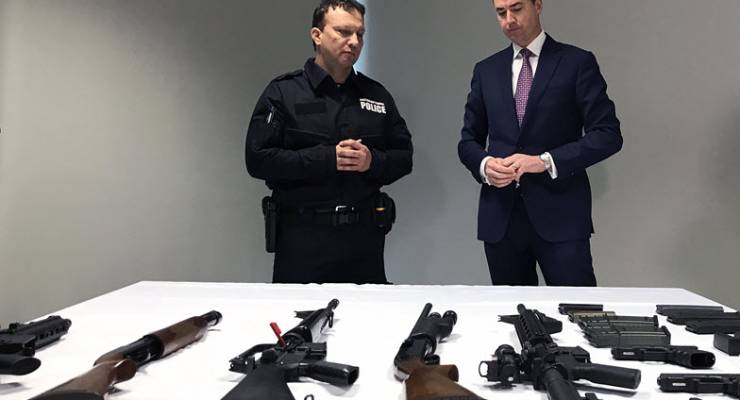
Justice Minister Michael Keenan’s announcement last week that the federal government would introduce the first national gun amnesty since 1996 has been widely reported. But what exactly is a gun amnesty, and why has the government decided to introduce one now?
What is a gun amnesty?
A gun amnesty is a period of non-prosecution that allows people to surrender their unwanted or unregistered firearms without fear of legal repercussions. This differs from a “gun buyback” where the government compensates gun owners for the surrender of firearms, though the two have previously run concurrently.
When was the last gun amnesty? And how many guns were handed in?
The last federal firearm amnesty was in response to the Port Arthur massacre in 1996 and ran from October 1, 1996, until September 30, 1997. The 1996 gun amnesty included both a period of non-prosecution and a national buyback scheme to compensate gun owners whose firearms had become illegal.
In 2003, following the Monash University shooting in 2002, the federal government introduced a new buyback to compensate owners of certain handguns that became unlawful.
While the new federal gun amnesty is the first since the one following Port Arthur, it is almost always possible to surrender unwanted guns to police. The founder of gunpolicy.org and associate professor of public health at Sydney University Philip Alpers told Crikey:
“Over two decades, each state and territory has made the same offer every day of the year. Contact a police station or a registered gun dealer and they’ll arrange to take it off your hands, register it for you, then sell or destroy it. This latest re-announcement merely re-advertises the status quo … a permanent amnesty for unwanted firearms.”
How does the new gun amnesty work?
The new federal gun amnesty will be in place between July 1 and September 30, 2017. During that time, anyone can surrender their firearms or have them registered at approved locations in every state or territory.
How many illegal guns are there in Australia? And how do we know that?
In short: there’s no way to be certain. According to Keenan, the government estimates that there are roughly 260,000 illegal guns in Australia. However, Keenan concedes that there is no way to be certain of the exact number of firearms, having told the ABC, “You never have a complete picture, you only can just make intelligence assessments based on the intelligence we have.”
Those numbers rely on a few different intelligence sources but are primarily based off police seizures and the interception of illegally imported firearms.
While a report by the Australian Criminal Intelligence Commission released last year, reinforced the estimate of 260,000 illegal firearms, it also cautioned there could be as many as 300,000 to 600,000 illegal firearms in the country.
Why is the government holding this gun amnesty now?
When announcing the new amnesty, Keenan specifically mentioned Australia’s “deteriorating national security environment” as a contributing factor leading to the amnesty.
The amnesty does follow several high-profile crimes involving illegal firearms, included Yacqub Khayre’s siege in Brighton on June 5. Police have said two shotguns belonging to Khayre were found after the siege, and have since charged a Westmeadows man for allegedly supplying Khayre with those guns.
Keenan has also said illegal guns were used in 2014 during the Lindt cafe siege and again in 2015 during the Parramatta shooting, which killed police accountant Curtis Cheng.
Do gun amnesties lead to less crime?
Both state and federal gun amnesties have resulted in a large number of firearms being either handed in or registered. Since Port Arthur, over 1 million guns have been surrendered to police during state or federal amnesties. A three-month amnesty in Queensland in 2013 resulted in over 19,000 weapons (including one flamethrower) being surrendered and a further 14,000 being legally registered.
However, simply having people hand in guns in doesn’t necessarily reduce the levels of gun violence. While the risk of an Australian dying of gun violence has fallen by more than 50%, since 1996, that amnesty involved the banning and subsequent buyback of a particularly dangerous class of guns.
Alpers has previously suggested that a policy of just firearm amnesty is ineffective at stopping gun violence. This is because people who willingly surrender firearms have typically only used them lawfully, and they bring in “rubbish guns” that no criminal wants anyway. Alpers has said the best policy response to increased gun violence occurs when governments target both illegal and legal gun ownership, thereby reducing the overall availability of guns in a market.








Nice article Will. What is to be done with pro-gun nutters like Leyonhjelm (and presumably his sidekick Latham)? Not to mention enthusiastic gun maniacs in the Nationals Party?
And there I was thinking it was thinking it was related to the red herring – a distraction, to be pulled out when things aren’t going the government’s way and they want to look like they’re doing soemthing?
I just hope these gun-happy hoons with penis issues take this opportunity to rid themselves of their substitutes.
…. I was also thinking it was simply related to the red herring – …. doing something?….
Criminals and other unsuitable gun owners always take the first opportunity to avail themselves of a gun amnesty.
Well known fact. In Bizarro World.
Re Gun “amnesty”: Lets hope actual destruction of handed in weapons occurs, rather than just de-registering and on-selling out the back door as happened last time e’g Gympie et al. Barry